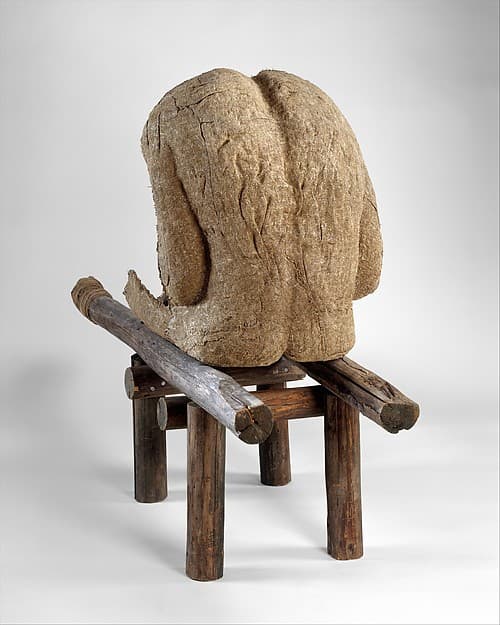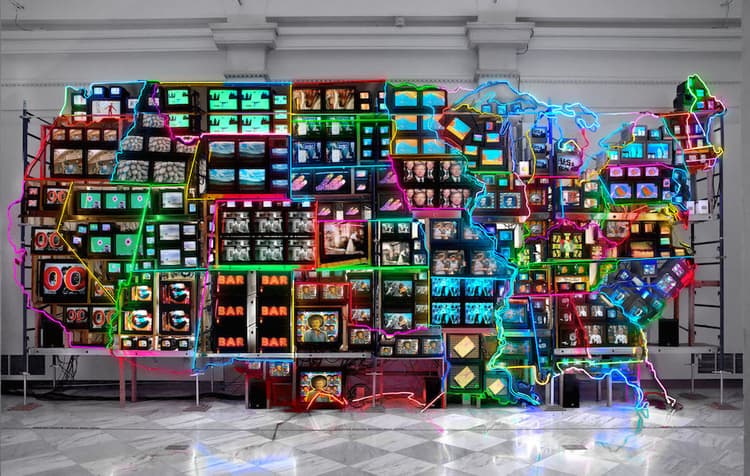Materials, Processes, and Techniques in Global Contemporary Art
Chloe Davis
8 min read
Listen to this study note
Study Guide Overview
This AP Art History study guide covers global contemporary art from the late 20th century to today, focusing on five key works: Horn Players by Jean-Michel Basquiat, Androgyne III by Magdalena Abakanowicz, Dancing at the Louvre by Faith Ringgold, Electronic Superhighway by Nam June Paik, and Stadia II by Julie Mehretu. The guide explores the themes, materials, techniques, and cultural contexts of each artwork. It also includes practice questions and exam tips covering multiple-choice, short answer, and free-response question formats.
#AP Art History: Ultimate Night-Before Study Guide
Hey there, future art historian! 🎨 This guide is your secret weapon for acing the AP Art History exam. We're going to break down some key contemporary artworks, focusing on what really matters for the test. Let's make this last-minute review count!
#1. Introduction: Global Contemporary Art
This section covers art from the late 20th century to today. Expect to see a mix of styles, mediums, and techniques that challenge traditional art forms. We'll dive into five major works that exemplify these shifts: Horn Players, Androgyne III, Dancing at the Louvre, Electronic Superhighway, and Stadia II. These pieces are not just pretty pictures; they're packed with cultural significance and innovative techniques. Let's get started!
Contemporary art often reflects social, political, and technological changes. Understanding these contexts is key!
#2. Horn Players (1983) by Jean-Michel Basquiat

- Artist: Jean-Michel Basquiat
- Year: 1983
- Medium: Acrylic and oilstick on three canvas panels mounted on wood supports
- Key Features:
- Two black figures playing horns, bold lines, and vibrant colors.
- Chaotic, layered background with text, images, and symbols.
- Reflects political and social issues of the time, including racism and marginalization.
- Significance: A powerful example of Basquiat's style, blending personal and cultural references to comment on contemporary society.
Basquiat's use of graffiti-style mark-making and his focus on identity are crucial elements to remember.
Think of Basquiat's Bold and Brilliant style, like a visual jazz solo, full of energy and improvisation.
#3. Androgyne III (1985) by Magdalena Abakanowicz

- Artist: Magdalena Abakanowicz
- Year: 1985
- Medium: Burlap, resin, wood, nails, and string
- Key Features:
- Abstract, humanoid figure made from rough, organic materials.
- Part of a larger series exploring the human form.
- Focuses on the universality of human experience rather than individual identity.
- Significance: Departure from abstract expressionism, using organic and organic-inspired forms.
Abakanowicz's use of burlap and other natural materials connects her work to themes of fragility and resilience.
Remember Abakanowicz's Abstact Androgyne, made of rough materials, like a figure emerging from the earth.
#4. Dancing at the Louvre (1991) by Faith Ringgold

- Artist: Faith Ringgold
- Year: 1991
- Medium: Acrylic on canvas with a tie-dyed, pieced fabric border
- Key Features:
- A story quilt depicting people dancing in front of the Louvre Museum.
- Combines traditional quilting with references to modern art and pop culture.
- Explores social and political issues, including cultural appropriation.
- Significance: Commentary on the representation of African Americans in museums and fine art.
Pay attention to how Ringgold uses the medium of quilting to tell stories and challenge traditional art hierarchies.
Think of Ringgold's Radiant Reflections, using quilts to tell stories and reclaim cultural spaces.
#5. Electronic Superhighway (1995) by Nam June Paik

- Artist: Nam June Paik
- Year: 1995
- Medium: Fifty-one channel video installation with custom electronics, neon lighting, steel, and wood
- Key Features:
- A large-scale installation with multiple monitors and screens.
- Represents a future world dominated by technology and the internet.
- Highlights the influence of electronic media on society and culture.
- Significance: Reflects Paik's belief in technology's potential to create a more connected world.
Don't confuse Paik's work with purely digital art. The physical installation and use of analog technology are crucial to its meaning.
Remember Paik's Pioneering Path, using technology to create immersive and thought-provoking art experiences.
#6. Stadia II (2004) by Julie Mehretu

- Artist: Julie Mehretu
- Year: 2004
- Medium: Ink and acrylic on canvas
- Key Features:
- Large-scale painting with overlapping layers of abstract forms, symbols, and marks.
- Evokes a sense of motion, energy, and the architecture of public spaces.
- Color palette predominantly black, white, and gray with pops of bright colors.
- Significance: Explores the intersection of politics, history, and the built environment.
Mehretu's use of layering and her exploration of architectural and urban themes are essential to understand.
Think of Mehretu's Multilayered Masterpiece, like a complex map of history and power, full of energy and movement.
#7. Final Exam Focus
Okay, you've made it this far! Here's what to focus on for the exam:
- Themes: Pay attention to how each artwork reflects social, political, and technological changes.
- Materials & Techniques: Be ready to discuss the specific materials and techniques used by each artist and why they are significant.
- Context: Remember the historical and cultural context of each piece. What was happening in the world when it was created?
- Connections: Look for connections between different artworks and movements. AP questions often combine multiple concepts.
Time Management: Don't spend too long on any one question. If you're stuck, move on and come back later. Start with the questions you know best to build confidence.
#Common Pitfalls to Avoid
- Describing instead of analyzing: Don't just say what you see. Explain why it matters.
- Ignoring context: Always consider the historical and cultural context of the artwork.
- Not using specific vocabulary: Use art historical terms correctly.
#8. Practice Questions
Alright, let's put your knowledge to the test! Here are some practice questions to get you ready:
Practice Question
Multiple Choice Questions
-
Which of the following best describes the medium used in Jean-Michel Basquiat's Horn Players? (A) Oil on canvas (B) Acrylic and oilstick on canvas (C) Watercolor on paper (D) Mixed media collage
-
Faith Ringgold's Dancing at the Louvre is significant for its: (A) Use of traditional European painting techniques. (B) Commentary on cultural appropriation and the representation of African Americans. (C) Focus on abstract forms and colors. (D) Depiction of historical events.
-
Nam June Paik's Electronic Superhighway is best described as: (A) A traditional sculpture made of bronze. (B) A large-scale video installation. (C) A series of landscape paintings. (D) A performance art piece.
Short Answer Question
Briefly describe how the materials and techniques used in Magdalena Abakanowicz's Androgyne III contribute to the sculpture's overall meaning.
Free Response Question
Compare and contrast the ways in which two of the following artists use abstraction in their works: Jean-Michel Basquiat, Julie Mehretu, and Magdalena Abakanowicz. In your response, consider the materials, techniques, and cultural contexts of each artist.
Scoring Breakdown for FRQ:
- Thesis (1 point): A clear thesis statement that addresses the prompt by comparing and contrasting the use of abstraction in the chosen artists' works.
- Artist 1 (2 points): Identification of the artist and their work, and discussion of how they use abstraction.
- Artist 2 (2 points): Identification of the artist and their work, and discussion of how they use abstraction.
- Comparison (2 points): Clear comparison of the ways in which the two artists use abstraction.
- Context (2 points): Discussion of the cultural and historical contexts of the artists and their works.
- Materials and Techniques (2 points): Discussion of the materials and techniques used by the artists and how they relate to the abstraction.
Remember to always connect your analysis back to the artwork’s cultural and historical context. This will earn you crucial points on the FRQs!
You've got this! Go ace that exam! 💪
Continue your learning journey

How are we doing?
Give us your feedback and let us know how we can improve





